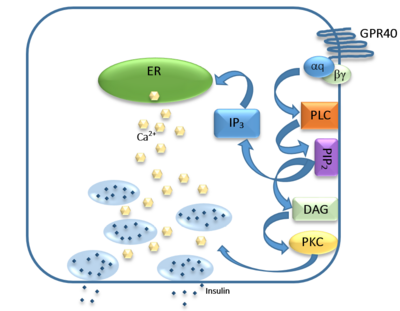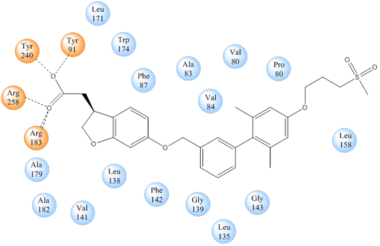User:Brittany Stankavich/Sandbox 1
From Proteopedia
(Difference between revisions)
| Line 8: | Line 8: | ||
== Introduction == | == Introduction == | ||
| - | '''Human GPR40 receptor''', hGPR40, is a [https://en.wikipedia.org/wiki/Free_fatty_acid_receptor free fatty-acid receptor] that binds to long chain [https://en.wikipedia.org/wiki/Fatty_acid free fatty acids], inducing [https://en.wikipedia.org/wiki/Insulin insulin] secretion. It is a G protein highly expressed in human pancreatic [https://en.wikipedia.org/wiki/Beta_cell β cells], brain, and endocrine cells of the [https://en.wikipedia.org/wiki/Gastrointestinal_tract gastrointestinal tract] <ref name=”REN”>PMID:26974599</ref>. However, what makes this receptor significant is that the secretion of insulin is [https://en.wikipedia.org/wiki/Glucose glucose] dependent. Thus, there needs to be an [https://en.wikipedia.org/wiki/Agonist agonist] bound, in addition to presence of glucose in the blood in order for insulin secretion to occur. This glucose-dependence makes GPR40 a target for [https://en.wikipedia.org/wiki/Diabetes_mellitus_type_2 type-2 diabetes] because it allows for increased glycemic control and therefore, low risk of [https://en.wikipedia.org/wiki/Hypoglycemia hypoglycemia]. | + | '''Human GPR40 receptor''', hGPR40, is a [https://en.wikipedia.org/wiki/Free_fatty_acid_receptor free fatty-acid G-protein coupled receptor] that binds to long chain [https://en.wikipedia.org/wiki/Fatty_acid free fatty acids], inducing [https://en.wikipedia.org/wiki/Insulin insulin] secretion. It is a G protein highly expressed in human pancreatic [https://en.wikipedia.org/wiki/Beta_cell β cells], brain, and endocrine cells of the [https://en.wikipedia.org/wiki/Gastrointestinal_tract gastrointestinal tract] <ref name=”REN”>PMID:26974599</ref>. However, what makes this receptor significant is that the secretion of insulin is [https://en.wikipedia.org/wiki/Glucose glucose] dependent. Thus, there needs to be an [https://en.wikipedia.org/wiki/Agonist agonist] bound, in addition to presence of glucose in the blood in order for insulin secretion to occur. This glucose-dependence makes GPR40 a target for [https://en.wikipedia.org/wiki/Diabetes_mellitus_type_2 type-2 diabetes] because it allows for increased glycemic control and therefore, low risk of [https://en.wikipedia.org/wiki/Hypoglycemia hypoglycemia]. |
== Function == | == Function == | ||
Revision as of 18:34, 20 April 2016
- User:Brittany Stankavich/Sandbox 1
hGPR40 Homo sapiens
| |||||||||||
References
- ↑ Ren XM, Cao LY, Zhang J, Qin WP, Yang Y, Wan B, Guo LH. Investigation of the Binding Interaction of Fatty Acids with Human G Protein-Coupled Receptor 40 Using a Site-Specific Fluorescence Probe by Flow Cytometry. Biochemistry. 2016 Mar 17. PMID:26974599 doi:http://dx.doi.org/10.1021/acs.biochem.6b00079
- ↑ Ichimura A, Hirasawa A, Hara T, Tsujimoto G. Free fatty acid receptors act as nutrient sensors to regulate energy homeostasis. Prostaglandins Other Lipid Mediat. 2009 Sep;89(3-4):82-8. doi:, 10.1016/j.prostaglandins.2009.05.003. Epub 2009 May 19. PMID:19460454 doi:http://dx.doi.org/10.1016/j.prostaglandins.2009.05.003
- ↑ 3.0 3.1 3.2 Morgan NG, Dhayal S. G-protein coupled receptors mediating long chain fatty acid signalling in the pancreatic beta-cell. Biochem Pharmacol. 2009 Dec 15;78(12):1419-27. doi: 10.1016/j.bcp.2009.07.020., Epub 2009 Aug 4. PMID:19660440 doi:http://dx.doi.org/10.1016/j.bcp.2009.07.020
- ↑ Hanson MA, Roth CB, Jo E, Griffith MT, Scott FL, Reinhart G, Desale H, Clemons B, Cahalan SM, Schuerer SC, Sanna MG, Han GW, Kuhn P, Rosen H, Stevens RC. Crystal structure of a lipid G protein-coupled receptor. Science. 2012 Feb 17;335(6070):851-5. PMID:22344443 doi:10.1126/science.1215904
- ↑ Li X, Zhong K, Guo Z, Zhong D, Chen X. Fasiglifam (TAK-875) Inhibits Hepatobiliary Transporters: A Possible Factor Contributing to Fasiglifam-Induced Liver Injury. Drug Metab Dispos. 2015 Nov;43(11):1751-9. doi: 10.1124/dmd.115.064121. Epub 2015, Aug 14. PMID:26276582 doi:http://dx.doi.org/10.1124/dmd.115.064121
- ↑ 6.0 6.1 Takano R, Yoshida M, Inoue M, Honda T, Nakashima R, Matsumoto K, Yano T, Ogata T, Watanabe N, Hirouchi M, Yoneyama T, Ito S, Toda N. Discovery of DS-1558: A Potent and Orally Bioavailable GPR40 Agonist. ACS Med Chem Lett. 2015 Jan 13;6(3):266-70. doi: 10.1021/ml500391n. eCollection, 2015 Mar 12. PMID:25815144 doi:http://dx.doi.org/10.1021/ml500391n


